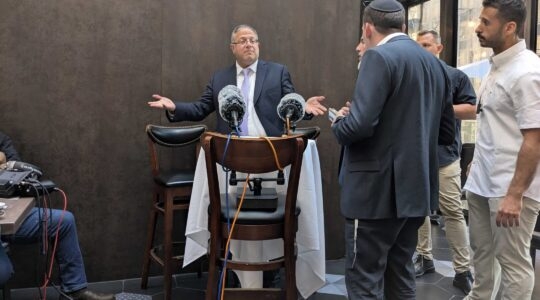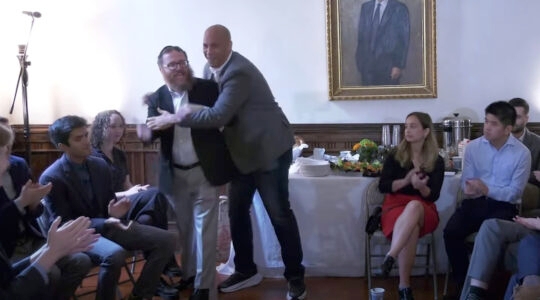EIN HOD, Israel (JTA) — Nomi Verchovsky’s running shoes crunch over the soot-covered shards of ceramic pots and bowls as she walks over the charred remains of her pottery studio and gallery, burned to the ground during the largest fire in Israel’s history.
Until last week, a small bookstore run by her husband crammed with 15,000 books stood next to her studio, but last Friday morning it, too, went up in flames, leaving behind a thick pile of ash.
“You can put your foot down in it and it will sink like snow,” the New York-born Vershovsky said matter-of-factly of the ashes.
She surveyed the damage, which includes three burned-out rooms in their adjacent home, which housed another 3,000 of her husband’s books — the rarest and most expensive of his collection. The studio and bookstore had been the couple’s livelihoods for years in Eid Hod, an artists’ colony tucked into the hills of the Carmel Mountain range.
The inferno that ravaged the Carmel Forest for four straight days, transforming one of Israel’s most tranquil vistas into a nightmarish scene of firewalls and blinding black smoke, claimed 42 lives, left hundreds homeless and destroyed 10,000 acres of forest. Firefighters brought the blaze to an end Sunday only with the aid of firefighting crews and planes from around the world.
“I want to thank all of you and each of you for coming so courageously, so promptly, to save lives and save land,” Israeli President Shimon Peres told an audience of foreign rescue crews Tuesday. “Many times Israel has sent its people to aid countries that suffered earthquakes or fires. This is the first time that we have needed assistance from others.”
As the area’s residents now turn to rebuilding, a sense of anger and blame is mounting. Israelis are asking how their high-tech, defense-driven nation could have been left so unprepared to deal with this sort of crisis despite repeated warnings that the Israeli firefighting corps was dangerously underfunded, underequipped and understaffed.
On Tuesday, Dan Chamizer stood outside of the small grocery store in Ein Hod where neighbors exchanged news of how some homes rung by fire miraculously were spared. The less fortunate, those whose homes were destroyed, came to the store to pick up blankets and bundles of clothes and supplies delivered by volunteers. About 20 homes in the village were destroyed or damaged by the fire.
“This was not a natural disaster but a disaster created by people who disdain nature,” Chamizer said, looking out at the black stain of burnt forest across a nearby clearing.
He had harsh words for Prime Minister Benjamin Netanyahu, who Chamizer said “acts as if he’s manager of one big air show. It’s all spin. As if he stopped this fire instead of saying, ‘I head a government that failed even though the writing was on the wall.’ ”
Chamizer noted that in 1998 a large forest fire also burned several homes in Ein Hod and caused significant damage in the Carmel Forest, but official recommendations to strengthen the firefighting services were never implemented.
Like other Ein Hod residents, he is angry that the police evacuated the village when some homeowners who know the terrain well wanted to stay behind to assist the firefighters.
Several snuck back into the village after being evacuated. Chamizer credited their return as the reason they were able to rescue their homes.
Ein Hod’s crooked streets and courtyards are now full of workers from the electric and phone companies repairing infrastructure damage, laying new underground cables and fixing telecommunication lines.
Across a two-lane road on the opposite hill sits the Yemin Orde Youth Village, which lost about a dozen buildings to the fire, including a section that housed orphans from the former Soviet Union. The village, which specializes as a home for adolescent survivors of trauma and displacement, dates back to the early years of the state, when it helped provide psychological support and a home to Jewish children who survived the Holocaust but were left orphans.
Yemin Orde has turned to the public for donations of money, clothes, school supplies and other materials lost to the fire, including home appliances and furniture.
Further up the winding road just outside of Kibbutz Nir Etzion, at a viewing spot overlooking a scorched section of forest, rangers and officials from the Keren Kayemeth LeIsrael-Jewish National Fund discuss plans to rehabilitate the Carmel.
“It will take time, a long time, but the KKL-JNF staff have experience in rehabilitating forests and we will bring the green back to the Carmel,” Efi Stenzler, world chairman of KKL-JNF, told JTA, quoting from a slogan for a new fundraising campaign launched by the organization in wake of the fire.
Stenzler rejected criticism of JNF’s planting the forest and others throughout the country with non-native pine trees, known for growing quickly but also catching fire quickly.
“This was not the reason for the fire,” he said, noting that most of the forest that burned was made up of native trees.
Stenzler and other officials said most of the rehabilitation efforts would be about rebuilding infrastructure like hiking trails, not about replanting trees. Instead, the forest for the most part will be allowed to restore itself naturally. Where replanting is deemed necessary, plans are to plant native broadleaf trees such as oak and carob in order to increase the area’s biodiversity.
Back in Ein Hod, a carpet of black ash is the only sign of a wooden house that once stood on a square plot just off a road that leads out of the village. Along its perimeter are the clay sculptures of round bellied female figures who survived the fire, silent witnesses to a home that no longer exists.
JTA has documented Jewish history in real-time for over a century. Keep our journalism strong by joining us in supporting independent, award-winning reporting.





